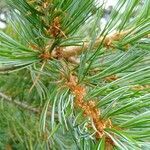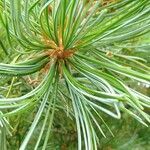An evergreen tree. It grows 9-22 m tall and spreads 6-7.5 m wide. The trunk can be 1 m across. The crown is cone shaped but develops a flat top when mature. The bark is purple-brown and smooth. The branches often occur in layers. The leaves are needle-like and occur in groups of five. They are soft and bluish. They are slightly curved and have a blue-white stripe on the underside. The female flowers are pink or purple at the ends of the shoots. The male flowers are yellow or brown. They are clustered around the shoot. The cones are blue-green and oval. They are 4-7.5 cm long by 3.5-4.5 cm wide. The seeds are nearly brown and mottled with black. They are 8-10 mm long by 7 mm wide.



